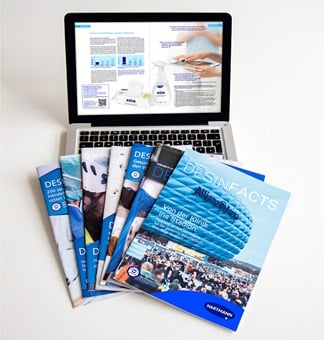DISINFACTS

In Germany, reprocessing of semi-critical medical devices is governed by the “Medizinprodukte-Betreiberverordnung” (MPBetreibV) which incorporates recommendations from the “Kommission für Infektionsprävention in medizinischen Einrichtungen und in Einrichtungen und Unternehmen der Pflege und Eingliederungshilfe” (KRINKO) and the “Bundesinstitut für Arzneimittel und Medizinprodukte” (BfArM) [5]. The MPBetreibV was last updated on 14 February 2025. In the updated version, a distinction is made for the first time between the reprocessing of products except single-use products (§8) and the reprocessing of single-use products (§9). According to §8 (1) MPBetreibV, the reprocessing of semi-critical medical devices must be performed using an adequate and validated method, ensuring the safety and health of patients, users, and third parties [5].
The above-mentioned institutes recommend the application of automated procedures for cleaning and disinfection since these can be validated [6]. In a statement of the Robert Koch Institute (RKI) from November 2020, this opinion was extended: to the knowledge of the board members, a manually performed reprocessing of semi-critical medical devices by wipe disinfection cannot be validated [7]. In October 2021, the state authorities responsible for medical devices and the BfArM agreed on this statement [8].
Certain medical devices cannot undergo automated reprocessing procedures due to constructional restrictions. In these cases, disinfection by immersion is recommended [8]. For transvaginal ultrasound probes, Korsolex® basic or Korsolex® extra can be used. After immersion disinfection, removal of residual disinfectant by sufficient rinsing is important, as well as storing in a way that excludes re-contamination. Moreover, manufacturers’ instructions regarding the product’s water permeability must be considered; thus, maybe not the whole medical device can be immersed.
The HARTMANN SCIENCE CENTER, in cooperation with Dr. Brill + Partner GmbH, Institute for Hygiene and Microbiology, has developed a method for reprocessing of transvaginal ultrasound probes based on wipe disinfection with Mikrobac® Virucidal Tissues [9]. This procedure allows for an effective reprocessing as soon as it is validated on-site and in accordance with the risk management of the facility.
In the reprocessing of medical devices, moving parts like the air or water valves of endoscopes pose a special challenge. A study from 2014 showed that about 87% of the investigated valves were contaminated [10]. During the application of endoscopes, the valves are moved up and down constantly. “In the course of cleaning and disinfection, these valves must be moved in a similar manner to cover all surfaces. This might be possible for a skilled user during brush precleaning; however, in immersion disinfection, exposure times need to be met, and this is not applicable anymore”, says Prof. Dr. Heike Martiny (Charité-Universitätsmedizin Berlin, Technische Hygiene) in an interview (06 November 2019).
Even Automated Endoscope Reprocessors (AERs) do not offer complete safety: “For this kind of automated reprocessing, it cannot be assured that all surfaces in the valves are exposed to the disinfectant for a sufficiently long time”, Prof. Martiny warns. “According to the guidelines, valves are part of the endoscope and, after being cleaned thoroughly using brushes, should preferably be reprocessed in an AER in a validated procedure.”
The operator is responsible for the reprocessing of semi-critical medical devices; however, Prof. Martiny calls for more responsibility of the manufacturers by providing detailed instructions for the reprocessing of the devices. “Elaborated instructions for the following measures must be available: First use on site, preparation before cleaning, cleaning, disinfection, drying, inspection and maintenance, packaging, sterilisation, storage, and transport.” In the ISO 17664, detailed requirements for this information supplied by the manufacturers are given.
In case of ambiguities, Prof. Martiny recommends disposable valves: “Using disposable valves is the safest measure for prevention of transmitting infections over using insufficiently reprocessed and thus potentially contaminated valves. By now, there are disposable valves for several types of endoscopes on the market. Their application saves time and can increase the efficacy of the reprocessing procedure as a whole.”
We thank Prof. Martiny for the interview (translated from German by HARTMANN SCIENCE CENTER).
References:
Use disinfectants safely.
Always read the label and product information before use.